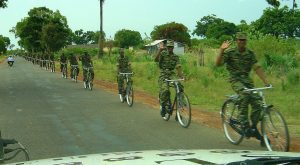71 South Asia: Political Geography – Ethnic Conflict in Sri Lanka
About 75% of Sri Lanka’s population are Sinhalese, a predominantly Buddhist people whose ancestors migrated to the island from northern India more than 2,500 years ago. Sri Lanka’s largest minority group are the Tamils, who make up about 15% of the country’s population. They are culturally related to the 70 million Tamils who live in southern India, and are descended primarily from migrants who crossed the Palk Strait in the 14th century and established a kingdom at Jaffna, on Sri Lanka’s north coast. Some Sri Lankan Tamils are descended from later migrants, including many who moved to the island when both India and Sri Lanka were under British rule. The Tamils are predominantly Hindu, with a significant Christian minority.
Tensions between the Sinhalese majority and Tamil minority arose almost immediately after the country gained its independence from Britain in 1948. The Tamils favored a federalist system of government, which would have given them greater political autonomy in the northern and eastern areas where they are predominant. But the Sinhalese majority imposed a more unitary system, which gave the national government in Colombo greater authority over the whole island.
For decades the Tamils justifiably accused the Sinhalese-dominated government of discrimination. The country suffered from race riots on several occasions, in which both Tamils and the Sinhalese suffered, but Sri Lanka’s security forces generally sided with the Sinhalese. Tamil frustration mounted as Sinhala was made the country’s official language, and as public education curriculum was engineered to marginalize the Tamil language and culture. Tamil protests were often violently suppressed. Frustration turned to anger as the government began to resettle Sinhalese farmers onto traditionally Tamil lands. In 1976, a militant organization called the Liberation Tigers of Tamil Eelam, more commonly known as the Tamil Tigers, was formed.
In 1983, the Tamil Tigers carried out an attack against the Sri Lankan military that resulted in the deaths of thirteen soldiers. Sinhalese mobs retaliated by assaulting Tamils living in Sri Lankan cities, and hundreds of people were killed. The Tigers responded with another series of attacks, and the Sri Lankan military responded with counterattacks. The Sri Lankan Civil War had begun.

The Tamil Tigers’ stronghold was always on the northern Jaffna peninsula, although much of the fighting took place along the northwestern and eastern areas of the island, where the Tamils were attempting to establish an independent state. In the early days of the war, most of the international community backed the Sri Lankan government, with India being the sole country aiding the rebels. That changed when India sent a large peacekeeping force to Sri Lanka to impose a ceasefire. In 1987, India’s military seized Jaffna, and the fighting ebbed. The Tamil Tigers, furious at what they viewed as India’s betrayal, assassinated Indian Prime Minister Rajiv Gandhi at a campaign event in India in 1991.
The Indian military withdrew from the country, and the Tamil Tigers regrouped. They were responsible for a number of terrorist attacks in Sinhalese areas, including bombings of Colombo’s central bank and airport, an attack on a Buddhist temple, and the assassination of Sri Lankan President Ranasinghe Premadasa.
A ceasefire was signed in 2002, but fighting erupted once again in 2006. Over the next few years, the Sri Lankan military made significant gains. The war ended in 2009, not with a peace treaty, but with government forces capturing all of the remaining Tamil Tiger strongholds and killing its senior commanders.
About 28,000 Sri Lankan military personnel were killed over the course of the war, as were more than 27,000 Tamil militants, and nearly 1,300 Indian troops. 40,000 civilians were killed in the conflict, and hundreds of thousands more were wounded or displaced from their homes. In the years since, Sri Lanka has been a generally peaceful place. Unfortunately, the conditions that led to the civil war haven’t really changed. That, coupled with Sri Lanka’s deepening economic and political crises, leaves open a distinct possibility of the war reigniting.
Did you know?
My Turn!
CITED AND ADDITIONAL BIBLIOGRAPHY:
Richard Masoner / Cyclelicious. Tamil Tigers Bicycle Platoon. Photo, 28 Oct. 2008. Flickr, https://www.flickr.com/photos/bike/2982504462/. Attribution-ShareAlike 2.0 Generic (CC BY-SA 2.0).


